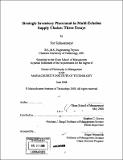| dc.contributor.advisor | Stephen C. Graves. | en_US |
| dc.contributor.author | Schoenmeyr, Tor (Tor Ivar) | en_US |
| dc.contributor.other | Sloan School of Management. | en_US |
| dc.date.accessioned | 2009-03-16T19:36:45Z | |
| dc.date.available | 2009-03-16T19:36:45Z | |
| dc.date.copyright | 2008 | en_US |
| dc.date.issued | 2008 | en_US |
| dc.identifier.uri | http://hdl.handle.net/1721.1/44741 | |
| dc.description | Thesis (Ph. D.)--Massachusetts Institute of Technology, Sloan School of Management, 2008. | en_US |
| dc.description | Includes bibliographical references (p. 134-137). | en_US |
| dc.description.abstract | A central question in supply chain management is how to coordinate activities and inventories over a large number of stages and locations, while providing a high level of service to end customers. One theoretically and practically important methodology for addressing this problem is the guaranteed service (GS) framework, in which the stages of the supply chain operate according to base stock policies, and prove guaranteed service to one another. Demand is assumed to be bounded. Previous work on GS models has established very effective algorithms for finding optimal safety stock placement. In the first essay of the thesis, we show how these methods can be generalized to handle problems with capacity constraints. Furthermore, we investigate orders that are censored (reduced so as to prevent deliveries greater than what can be processed). We find safety stock reductions, sometimes even below what was needed in the no-constraint situation. In the second essay, we investigate a situation in which different parts of the supply chain are controlled by different parties, each of which selfishly applies its own GS optimization. We find that provided that the parties can agree on the right service time between them, it will be in their own interests to maintain the globally optimal solution (i.e., the system is incentive compatible). This suggests that the GS framework is better suited for coordination, than are other frameworks analyzed in the coordination literature. Finally, in the third essay, we apply the GS framework to a setting where orders are driven by forecasts and schedules, rather than by past demand as in previous GS work. We show precisely how the demand bound can be replaced by a bound on forecast errors, and that existing optimization methods can be used. | en_US |
| dc.description.abstract | (cont.) In a case study, we obtained data from the supply chain of an electronic test system, as well as characterized the forecasting process. We found that incorporating the forecast process led to 25% reduction of safety stocks. | en_US |
| dc.description.statementofresponsibility | by Tor Schoenmeyr. | en_US |
| dc.format.extent | 137 p. | en_US |
| dc.language.iso | eng | en_US |
| dc.publisher | Massachusetts Institute of Technology | en_US |
| dc.rights | M.I.T. theses are protected by
copyright. They may be viewed from this source for any purpose, but
reproduction or distribution in any format is prohibited without written
permission. See provided URL for inquiries about permission. | en_US |
| dc.rights.uri | http://dspace.mit.edu/handle/1721.1/7582 | en_US |
| dc.subject | Sloan School of Management. | en_US |
| dc.title | Strategic inventory placement in multi-echelon supply chains : three essays | en_US |
| dc.type | Thesis | en_US |
| dc.description.degree | Ph.D. | en_US |
| dc.contributor.department | Sloan School of Management | |
| dc.identifier.oclc | 298551173 | en_US |
